


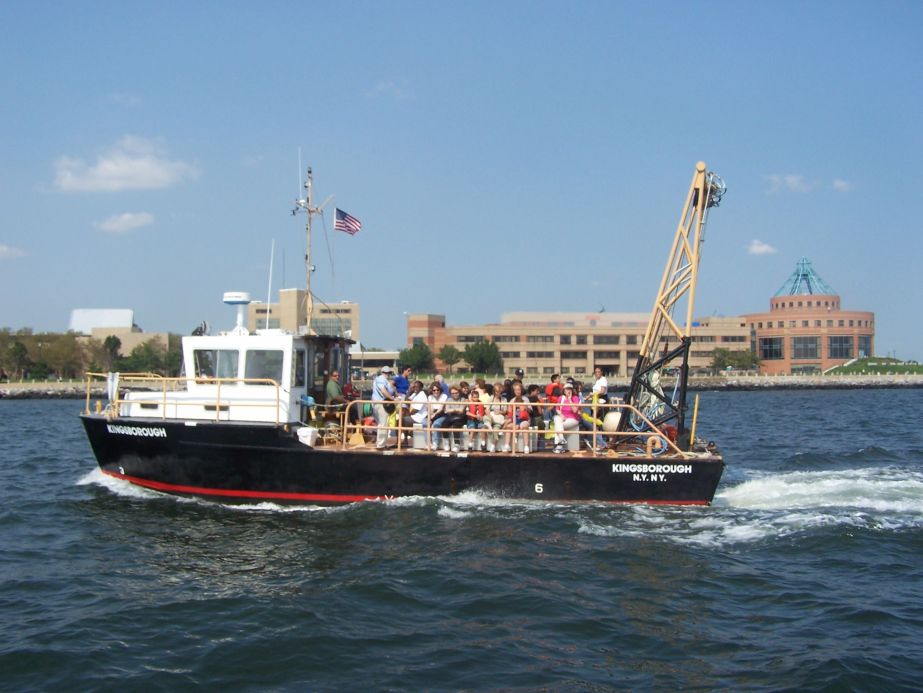
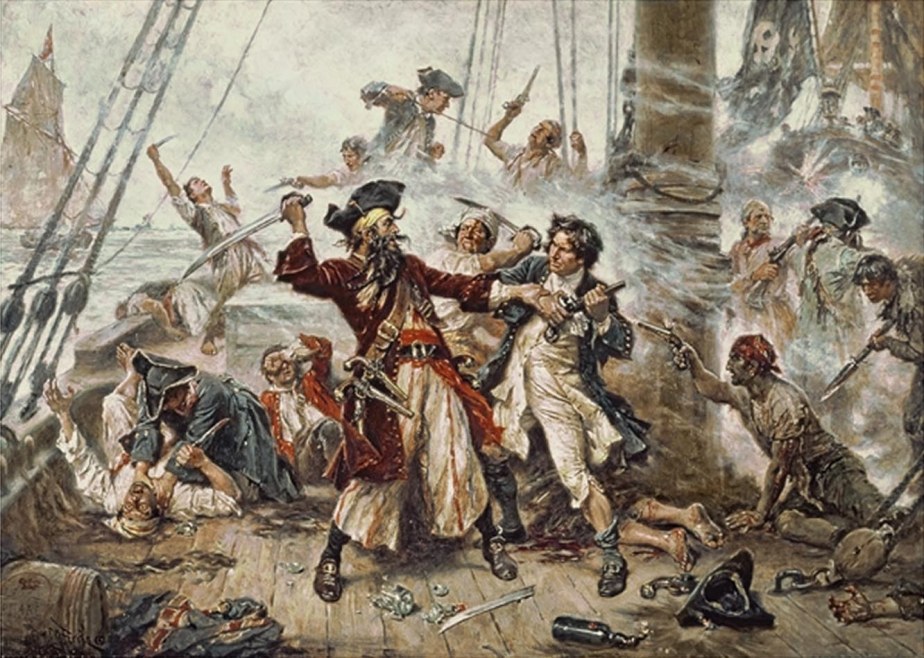
Aargh and a yo-ho-ho! , Get out your shovels!
Sometimes when you stare out to the Gil Hodges Marine Parkway Bridge on the shores of KCC, connecting Brooklyn to Queens , the focus can easily shift in time to the Jamaica Bay of the 1600’s and the lore of smugglers and treasure buried at our shoreline and beneath us.
Pirates at Kingsborough and treasure buried under our feet by the MAC Building or the T-buildings?
Well, there used to be pirates in Brooklyn. Real honest-to-goodness, swashbuckling pirates! And they had to bury their treasure somewhere! Many believe here at KCC.
For hundreds of years, stories and legends of smugglers and pirates hiding their ill-gotten booty around the Jamaica Bay shoreline have stubbornly – and compellingly – persisted, anecdotally and in the fantasies of would-be millionaires. The time has come to reveal some of the facts of these tantalizing tales.
Captain William Kidd, along with Blackbeard, perhaps the most legendary pirates, was said to have buried his plundered treasure by Jamaica Bay in Brooklyn. Supposedly, Kidd owned quite a bit of land in New York, including several plots in Canarsie, Sheepshead Bay, Manhattan Beach and Coney Island. Unfortunately, he was caught and subsequently hanged in England in 1701 and, like a true pirate, died before he revealed where his treasure was buried. Many who knew Kidd suspected he buried his loot in – at the time – a sparsely populated area then called the Sedge or Sedge Bank now called Manhattan Beach.
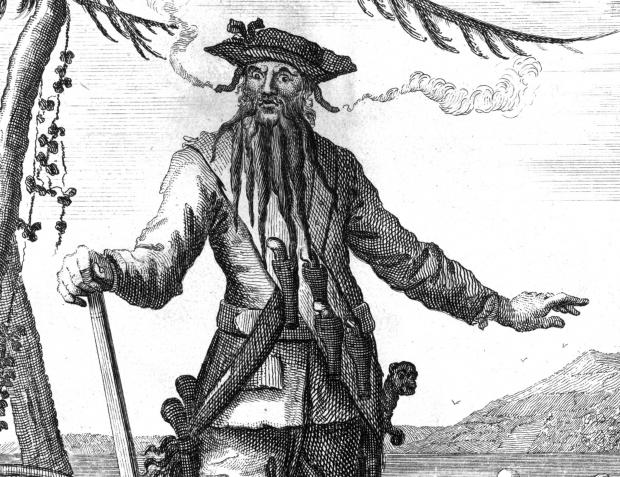
Though he may have been the most famous pirate associated with Brooklyn, Captain Kidd was not the most interesting. He was a true gentleman when compared to Charles Gibbs and Thomas Wansley, two of the most notorious and brutal sea-faring criminals of their time. Gibbs seems to have been the stereotypical, dastardly pirate. His cruelty was so well known that Edgar Allan Poe allegedly used him as the basis of the title character in his only novel, The Narrative of Arthur Gordon Pym.
In November 1830, the 36-year-old Gibbs, with a long history of treachery, worked as a crew member aboard the brig Vineyard, when he plotted a mutiny against the ship’s captain, William Thornby. Once Gibbs heard that along with bales of cotton and casks of molasses the Vineyard held $54,000 in “species” (coins made of precious metal), the fate of the ship and its crew was sealed ( today’s worth in the millions).
After throwing Thornby overboard, Gibbs persuaded most of the ship’s crew to go along with the mutiny by breaking open barrels of rum and offering to share the bounty with them. The crew members who did not participate were murdered or thrown overboard and left to drown on the high seas. One story that exemplifies Gibbs’ cruelty recounts an incident where one of the crew members tried to climb back aboard the ship only to have Gibbs chop his hands off with an ax.
After Gibbs took command of the Vineyard, he ordered the vessel, with the remainder of her crew, sail toward Long Island. On the morning of November 23, 1830, the Vineyard, with Gibbs, his cohort Thomas Wansley and the stolen treasure aboard, was anchored in Jamaica Bay right by the college or at the college itself.

Gibbs, Wansley and the crew members all disembarked in several boats taking the captain’s clothes, a keg of Mexican gold coins and many bags of spices. The Vineyard was then set ablaze. In case they were caught and questioned, the crew prepared a cover story about being shipwrecked.
From this point on, what really happened is unclear. As with all tales of treasure, there are several dead ends.
Several sources have Gibbs and Wansley staying overnight in the Canarsie home of 21-year-old William Johnson (Johnson was said to have lived in Canarsie until 1907). Allegedly, Johnson’s suspicions were aroused the next day when Gibbs and Wansley paid him with a bag of Mexican coins for his help. In fact, Johnson had already become suspicious the night before when the pirates asked him to lend them a horse and wagon. They said they wanted to move something “heavy” from a small boat onto land. Johnson obliged, not knowing he was dealing with pirates. When Gibbs and Wansley brought the wagon back, it was empty. The loot was apparently hidden somewhere between the college and the Canarsie shore and Johnson’s house.
Johnson eventually turned Gibbs and Wansley over to authorities in Gravesend (now known as Sheepshead Bay next to Kingsborough). They paid for their heinous deeds on April 22, 1831, on the gallows at Bedloe’s Island. Part of their sentence stated that their bodies were to be cut down and given to the College of Physicians and Surgeons for dissection. Gibbs and Wansley were the last pirates ever hanged in New York. According to the surgeon who dissected the bodies, Gibbs was “rather below middle stature, thick-set and powerful. Wansley was a perfect model of manly beauty.”
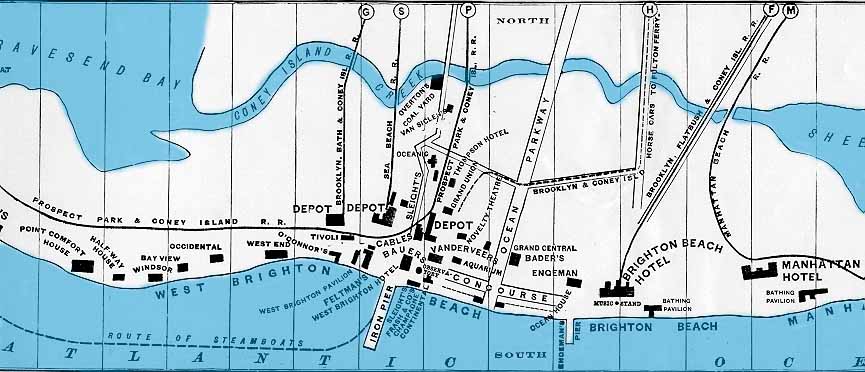
Many people might be surprised that Wansley was a black man. In fact, about one-quarter of all pirates in the 17th and 18th centuries was black. Some were runaway slaves and some were free men. But, according to pirate historian Kenneth Kinkor, the black pirates found that their treatment on a pirate ship was better than their treatment on land. “A black man who knew the ropes was more likely to win respect than a landsman who didn’t.”
Gibbs and Wansley never revealed the whereabouts of the stolen treasure during their trial, but there has been speculation about where the money was hidden. Some accounts say it was buried on Barron Island (sic), off Long Island. Others say it was dug up from there and reburied underneath Kingsborough. Other stories recount that it was buried on Great Barn Island, also known as Barrens Island, which is now Floyd Bennett Field. There is also a tale that names Pelican Island, which is now Coney Island. There is even one account where the residents of what is now Kingsborough’s 71-acres, found the treasure washed up on the beach after a winter storm in 1839.
This same tale continues that the rest of the loot was moved eastward, divided up and reburied in two separate places by William Johnson and his brother, John. It was said that one of the brothers returned and dug up one of the parcels but never found the rest of the treasure. Another version has the local sheriff along with William Johnson, searching the sandy beach for the buried treasure. Supposedly, they found nothing and most of the treasure is still out there somewhere waiting to be discovered by some clever Canarsien.
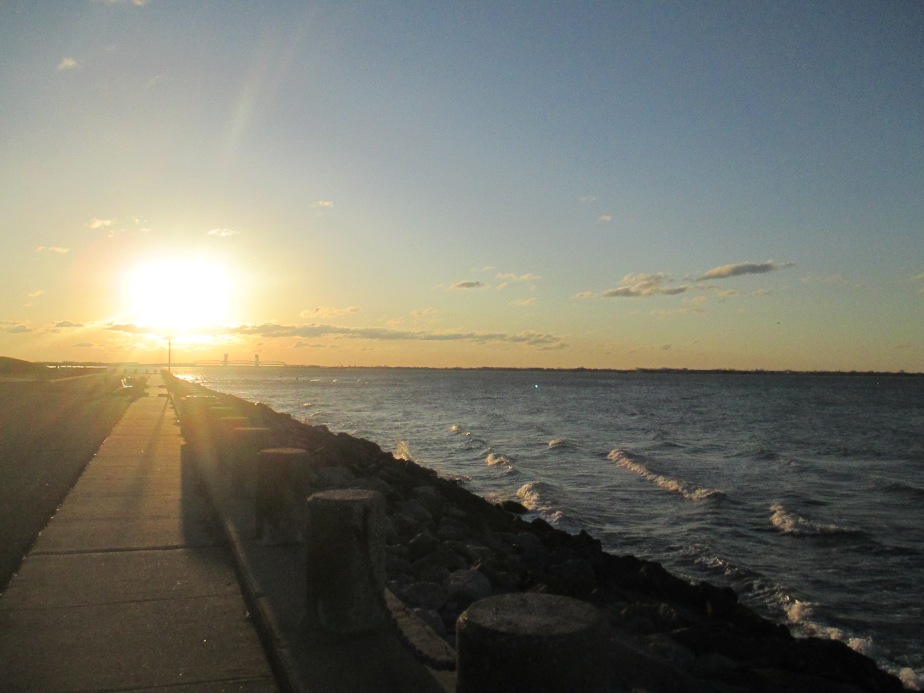
And speaking of clever Brooklynites, what became of William Johnson?
He was a founding member of Grace Church, located on East 92nd Street, and is buried in a Canarsie Cemetery.
His great-great-granddaughter, Randy Lawson, currently living in Long Island, revealed that a distant cousin told Lawson that another relative possessed a Mexican coin that was passed down in the family. This coin might have come from the buried pirate treasure or it might have been one of the coins the pirates paid the Johnson brothers for letting them stay in their home.
The general consensus of these accounts seems to indicate that not all of the treasure was found and that some of it is still buried here. Intriguingly, there is an existing map dating back to 1873.
In his final years, William Johnson lived with his granddaughter on Flatlands Avenue. It is alleged that he searched the surrounding neighborhoods as he continued to look for the lost treasure for the rest of his life.
The chances are that the treasure is still somewhere out there, buried in the sandy soil or under the rocks of Kingsborough-perhaps by the opening to Sheepshead Bay…could it be just in the fertile imaginations of treasure hunters everywhere or do we have Pirate booty beneath our community college campus?
Get out your metal detectors.
“I could do nothing but Brooklyn shows for the rest of my career, and I could die ignorant.” Anthony Bourdain
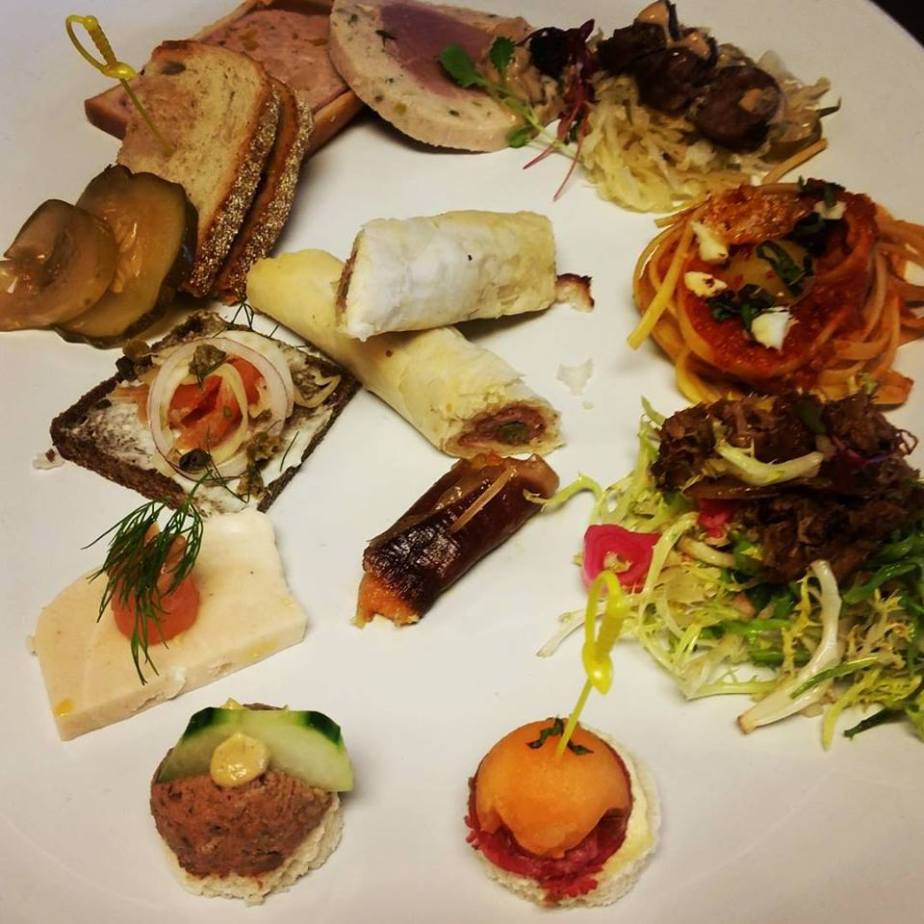
The Culinary Arts program at Kingsborough Community College is a comprehensive training program designed for successful entry into the creative, high-paced workplaces of the food industry. We have two programs to set you on your career path-
Associate of Applied Science Degree in Culinary Arts—a 60-credit, 2-year college degree including over 600 hours of hands-on kitchen classes and internship experiences
Certificate in Culinary Arts and Food Management—a one-year certificate designed for students who already have a college degree in another field.
For more info on the food program,contact the Director of the Culinary Arts Program, Chef Smyth at: Thomas.smyth@kbcc.cuny.edu or call the Tourism and Hospitality Department at: 718-368-5143

“It happened every single day in Brooklyn: awaken to fresh glory, fall asleep to blight and ruin.”
― Kate Christensen –“The Astral”
The opening reception for Daumier’s Paris: Caricature and Cultural Trauma in the Age of Haussmann will be held on Tuesday, April 19, 2016, from 3-5 pm in the Kingsborough Art Gallery. This exhibition will feature a considerable number of caricatures from the satirical magazine Le Charivari, as well as many period photographs documenting the dramatically changing landscape of Paris under the direction of Baron Georges Haussmann (1809-1891), the urban planner under Napoleon III. While historical in nature, the exhibition will surely resonate with contemporary viewers in Brooklyn and elsewhere who are concerned with issues of gentrification and urban design. It will no doubt be of interest to numerous disciplines on campus, and instructors are welcome to bring their classes to the exhibition during its run (April 20 – May 18).
The exhibition will be curated by Jennifer Pride from Florida State University, who has written her dissertation on the cultural trauma caused by Haussmannization in nineteenth-century Paris. She will be giving a lecture on this topic in early May. More information to follow.
The Art Gallery at Kingsborough Community College is delighted to bring this exhibition to our students, faculty, administration and staff. Hope to see you there!
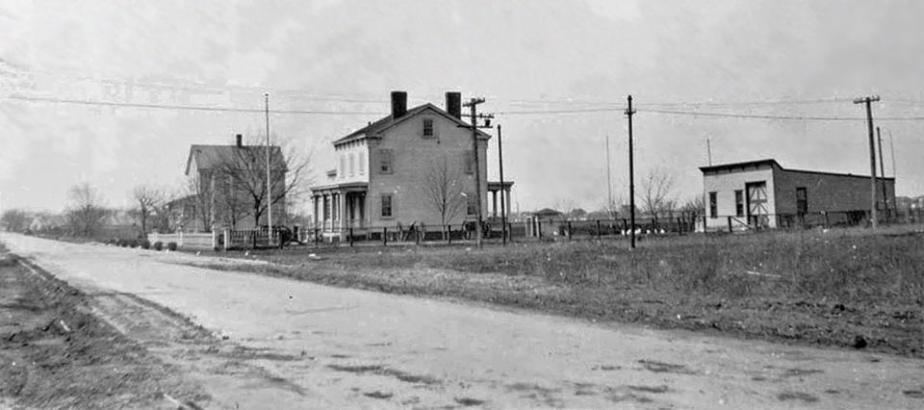

The KCC Urban Farm is an organic, year-round food production site located on the campus of Kingsborough Community College. We grow a wide variety of vegetables, herbs and flowers, we compost food scraps from the Culinary Arts Program, and we host tastings, events, The KCC Farm provides students with urban farming expertise and first-hand experience building a more sustainable food system. Training through credit, non-credit and workforce development programs emphasizes hands-on experience and practical knowledge. Our goals are to prepare students for careers in the rapidly expanding local food economy, build a greater understanding of food systems through growing fresh fruits and vegetables, and to educate students on the benefits of leading healthy lifestyles.
The farm is located at the Kingsborough Community College campus between T8 and T2. To volunteer, or for more information, about the farm, please call or email us at 718.368.6578 or KCCurbanfarm@kbcc.cuny.edu.
For news and updates about the KCC Urban Farm, visit our blog: http://cewdkbcc.com/category/kcc-urban-farm/
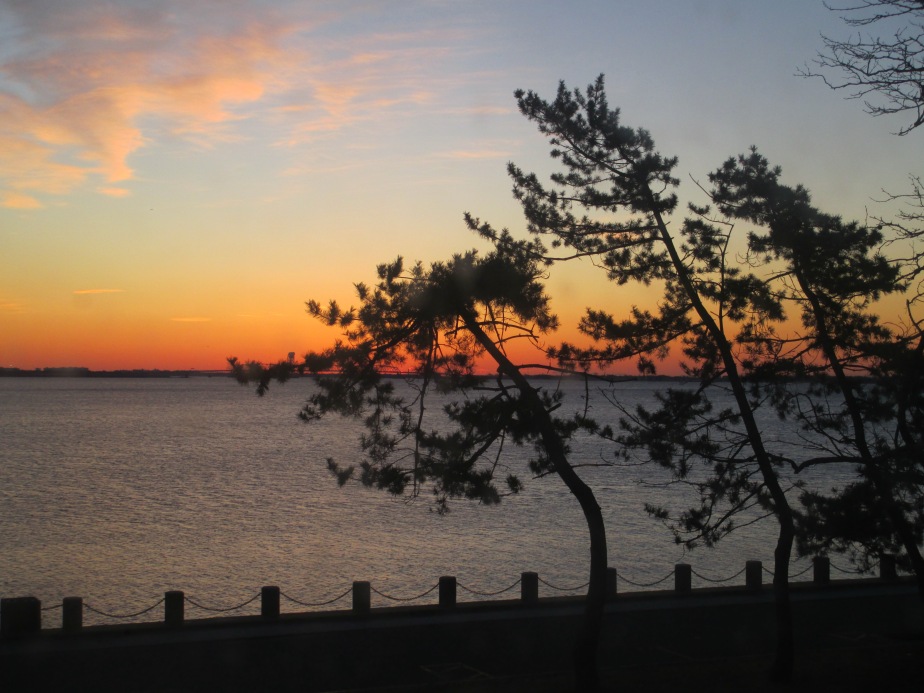
“Brooklyn was a dream. All the things that happened there just couldn’t happen. It was all dream stuff. Or was it all real and true and was it that she, Francie, was the dreamer?”
― Betty Smith- ” A Tree Grows in Brooklyn”
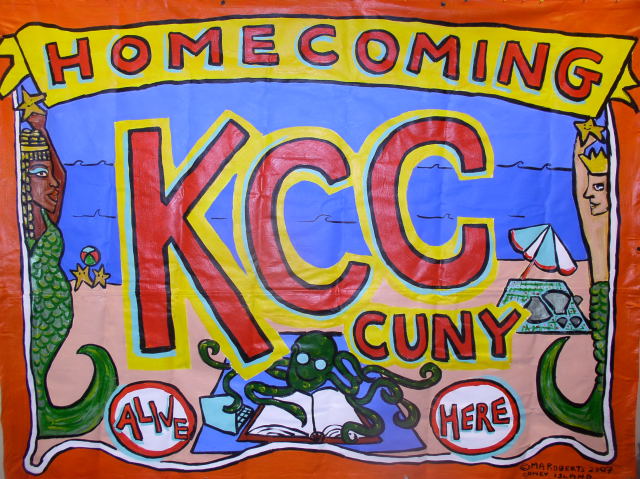
Marie Roberts Banner for Kingsborough’s Homecoming Days
Farleigh Dickinson University Professor Marie Roberts has recently gained even more acclaim and attention with her art work of Sideshow and Coney Island banners her recent displays of work appearing at the Brooklyn Museum and P.S. 1 in New York City drew huge crowds and lots of positive press.
Just a few years ago, in 2007, Kingsborough was proud to host a display of her work in our KCC Art Gallery along with a specially designed banner for our Homecoming Day celebration.
Snake oil and sideshows are normal to Marie Roberts. Her father’s family was involved in early 20th Century Coney Island; her grandfather was acting battalion chief of the Coney Island District and her Uncles Harry and Guy were at Dreamland the night of the fire. “My Uncle Lester and my father worked at the Dreamland Circus Sideshow in the 1920’s.”
“Coney is so peopled with ghosts and memories, there is no place in Coney Island that is totally mine, except for Coney Island USA.”
That not for profit arts center is a haven where both sides of my life can co exist – the academic and the sideshow. It is the only place in the earth where I feel back at home, with my relatives (deceased) gathered around. Coney Island USA lets me paint as much as I want. Making the corner of West 12th and Surf beautiful is a testament to my family, and a challenge to my present as an artist.
Since 1997 I have been exploring the contemporary sideshow banner; using the traditional format, I have been experimenting with the use of acrylic. I believe that one has to know and understand one’s tradition and medium in order to take it further. I believe that a college education is an opportunity to replace one’s ignorance with a broader prospect. –
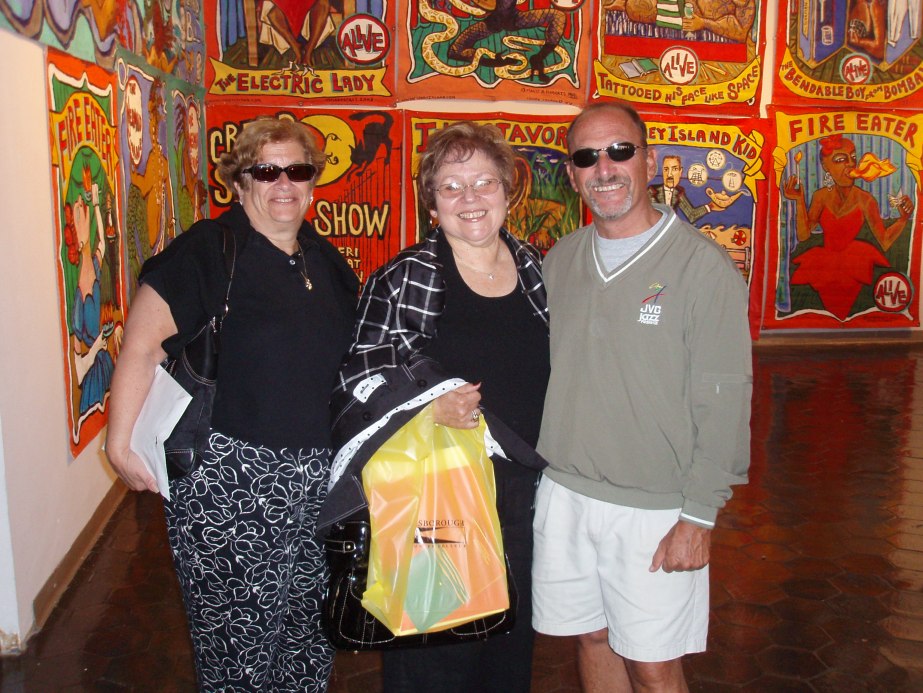
Born in Brooklyn, Professor Roberts lives and works in Brooklyn. She studied painting & drawing at CUNY with both a BA from Brooklyn College & an MFA from Queens College.
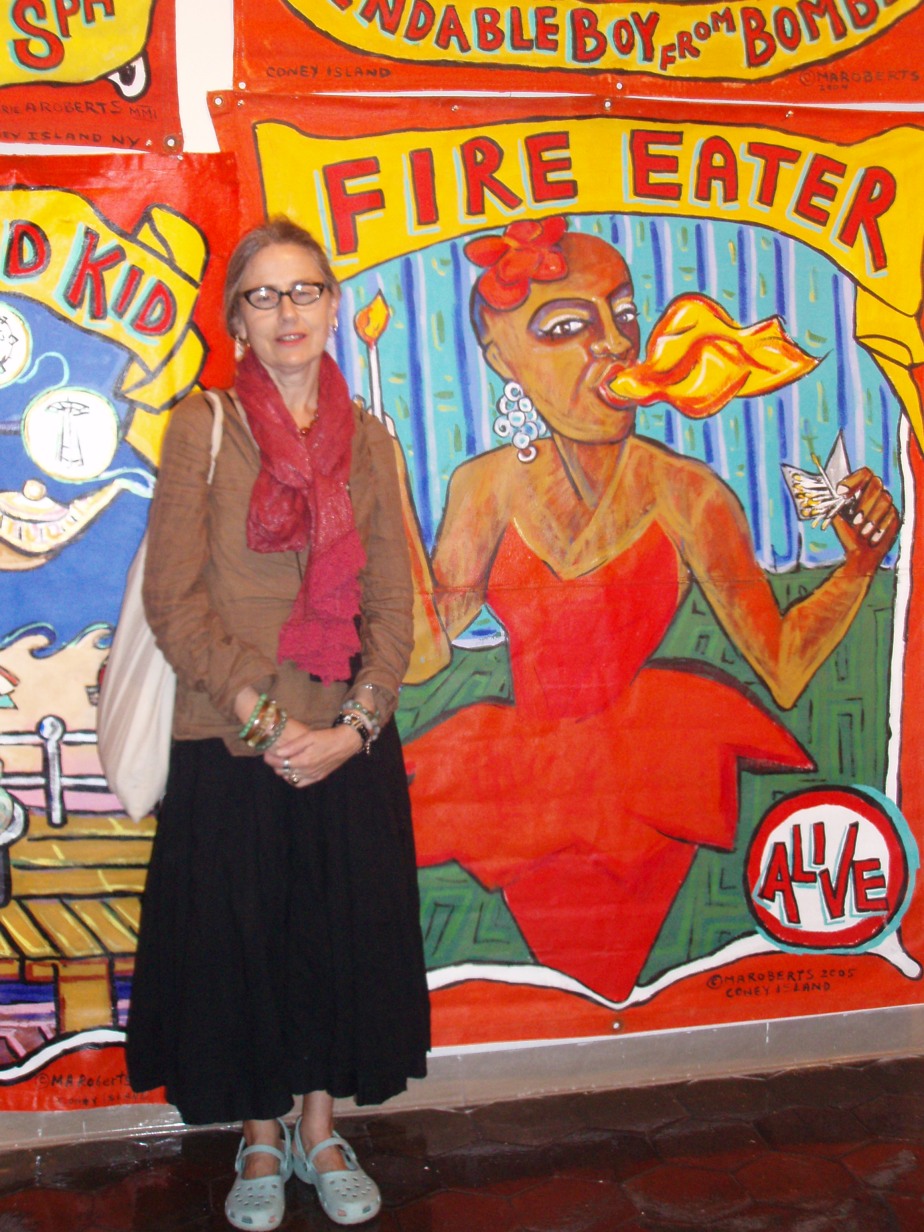
She is currently a Professor at Fairleigh Dickinson University, in both painting and drawing.and is also an Artist in Residence, Coney Island USA
![hartstein[1]](https://kingsboroughblog.files.wordpress.com/2016/03/hartstein1.jpg?w=924)
Kingsborough Community College (KCC) and its Office of Alumni Relations is reaching out to all alumni from its first graduating class in 1966, to welcome them back home to attend a reunion. KCC will be holding a 50th Anniversary Gala on Saturday, May 7, 2016 at 6:00 pm in there, newly renamed, conference center overlooking Jamaica Bay and the Atlantic Ocean the Lighthouse at Kingsborough Community College, (formerly the MAC Rotunda).![50info[1]](https://kingsboroughblog.files.wordpress.com/2016/03/50info1.png?w=924)
The college has already formed a committee of dedicated alumni from the class of 1966 to plan and organize the event but is still searching for many members of the class who have yet to be found.
“We have up to date addresses for approximately half of the graduating class of 1966,” said KCC Alumni Director, Laura Glazier-Smith ’87 “but we will need people’s assistance in reaching out to the other half who have lost touch with us over the years.”
In 2004, Michael Sedar, an alumni from the class of 1966, described the college of 1964 when the 1st class entered in a letter –
![image[6]](https://kingsboroughblog.files.wordpress.com/2016/03/image6.jpg?w=924)
“Back in September, 1964, along with a group of fresh H.S grads from all over Brooklyn, I entered into CUNY’s newest institution of higher learning – Kingsborough Community College. As I recall, there was about 500 eager young students – some starting their higher education here because they weren’t accepted into other colleges because of lower grades, others because of financial considerations and, probably the largest reason for the young men, an academic deferment from the Selective Service System that saved them from being drafted into the U.S. Army with a sizable chance of being sent to Vietnam. Back in 1964, the Manhattan Beach Campus was still owned by the U.S. Government who developed the land into a Coast Guard base. In the beginning, Kingsborough had two campuses – Mid-Brooklyn and P.S. 98 on Avenue Z. I believe that Mid-Brooklyn was a Masonic Temple that was leased to CUNY because of the size of the first class. P.S. 98 was a former elementary school that was given over to CUNY and was where I and most of the other students spent the first year of our college lives.”
![image[3]](https://kingsboroughblog.files.wordpress.com/2016/03/image3.jpg?w=924)
“In the spring of 1965, the school offered financial aid to lower income bracket students and that included me. The base was transferred to CUNY and it was the job of us student workers to clean up the place that had really been vacant for at least 10 years. We had to sweep up the streets, pile up all the wood (driftwood, old stairs and assorted furniture), and assorted other tasks while workman converted the former military barracks into usable classrooms and offices. In September, 1965, 2 large buildings acted as the college. All students then came from P.S. 98 to the “Manhattan Beach Campus” along with a new group of freshman. There was a library, science labs and even an athletic field all amongst a bevy of empty military warehouses, Quonset huts and barracks.”
“Kingsborough gave me a sense of myself and my individuality. It allowed me to pursue interests I didn’t even know I had. It was a great academic experience and it was fun,” said Leda (Pankin) Favale, an alumna from the Class of 1966.
“I look forward to this reunion to reconnect and catch up with my fellow classmates who shared this unique experience of being in the first graduating class of KCC.”
“This will be a joyous, inspiring and great celebration of one of the best community colleges in the United States and we hope to have as many members of the original graduating class in attendance as we can,” said President Herzek.
If you are a graduate of Kingsborough’s Class of 1966 or happen to have information as to a class members whereabouts please contact us at Laura.Glazier-Smith @kbcc.cuny.edu